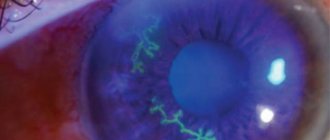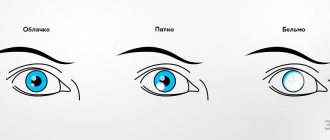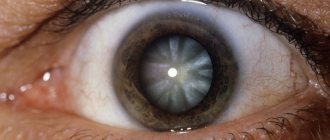Phlegmon of the orbit of the eye is one of the most complex and dangerous ophthalmological diseases. Untimely treatment of which can lead to both serious complications and death. Phlegmon of the orbit (orbital cellulitis) is a purulent-inflammatory pathology of the fiber of the orbit of the eye, which leads to its melting and necrosis. Phlegmon of the orbit of the eye requires correct diagnosis and differentiation, since its symptoms are similar to a number of other inflammatory diseases. The disease progresses very quickly and manifests itself in severe inflammation and swelling of the eye tissue in a short period - from 1-2 hours to two days.
Causes of formation of phlegmon of the orbit of the eye
The etiological factor of this disease is infection of the orbital tissue by bacteria. Pathogens enter the tissue through the bloodstream from purulent foci, or through direct contact. Most often, the pathogens are various types of staphylococci (golden, white, etc.), streptococci (hemolytic, viridans, etc.), sometimes E. coli or pneumococci and other pathogens. In the initial stages, small pustules appear, which eventually combine into large abscesses.
There are several causes of infection leading to orbital phlegmon:
• Orbital injuries, with subsequent infection of tissues by pyogenic microflora; • Entry of infected foreign bodies into the orbital tissue; • Purulent diseases of the eye: dacryocystitis, phlegmon of the eyelid, barley, etc.; • Purulent or inflammatory lesions on the facial skin: boils, carbuncles, erysipelas, etc.; • Purulent-inflammatory pathologies in the paranasal sinuses; • Inflammatory or purulent diseases of the teeth, upper jaw; • Common acute infectious diseases: scarlet fever, measles, influenza, typhus, etc.; • Purulent metastases in sepsis.
Consequences
In rare cases, phlegmon of the orbit can provoke the development of quite severe complications:
- abscess in brain tissue;
- sepsis;
- formation of blood clots in sinus vessels;
- meningitis.
This disease is considered extremely rare, but extremely dangerous. In all cases, it progresses extremely rapidly, so if the first symptoms occur, you should immediately contact a qualified ophthalmologist.
Symptoms of orbital phlegmon
The disease is most often unilateral.
The development of the inflammatory process occurs suddenly and very quickly - most often a few hours are enough, depending on the body’s resistance. Phlegmon of the orbit is manifested by the following symptoms: 1. Sharp pain in the affected orbit and surrounding soft tissues, with eye movements and palpation, the pain intensifies; 2. Intense headache; 3. Severe hyperemia, swelling, inflammation of the eyelids; 4. The eyelids are tense, do not open, and have a pronounced red-violet tint; 5. Fever and general weakness, characteristic of general intoxication; 6. Immobility of the eyeball develops quickly; 7. The eyeball shifts; 8. Against the background of the development of the inflammatory process, chemosis of the conjunctiva may occur; 9. The mucous membrane moves outward behind the eyelids; 10. Vision drops sharply.
If the optic nerves of the orbit are compressed by the enlarged conjunctiva, trophic complications are possible. In case of infection and inflammation of the optic nerve, retina and choroid, congestive processes, panophthalmitis, and choroiditis may develop. The outcome may be complete atrophy of the eyeball. In this case, the purulent process does not spread and is localized in the orbit, an abscess is formed. Without timely treatment, spontaneous opening of the abscess through the skin or conjunctiva may occur. In the most advanced cases, the purulent process spreads to the paranasal sinuses and meninges. The generalization of this process develops into sepsis, the consequence of which can be death.
How does development happen?
Barley is an infectious disease in 95% of cases, the causative agent of which is Staphylococcus aureus. The bacterium enters the eye through the bloodstream if the immune system is weakened, or from the outside if hygiene rules are not followed.
The most common type is localized at the edge of the eyelashes - in this case, the hair follicle of the eyelash becomes inflamed. In some cases, the abscess can be deep - then the meibomian gland is affected, while the course of the disease is usually milder, but there is a danger of eruption of pus into the orbit or the formation of a chalazion.
The first symptom of stye is slight redness and swelling along the edge of the eyelid. Within 2-3 days, the abscess develops, its core is formed, and, in the absence of complications, it opens on its own and heals quite quickly.
In severe cases of the disease, symptoms may include increased body temperature, enlarged lymph nodes, headache, swelling of adjacent tissues - all this indicates the development of an inflammatory process and requires consultation with a specialist.
| Name of service | Price |
| Consultation with an ophthalmologist (visual acuity test, examination of the anterior segment of the eye at a slit lamp, autorefractometry, examination of the fundus with a narrow pupil) | 2,800 rub. |
| Selection of simple glasses alone / without diagnostics | 900 rub. |
| Selection of contact lenses, consultation, training / without diagnostics | 2,200 rub. |
| Summarizing the examination results and drawing up an individual treatment program 1 | 500 rub. |
| View the entire price list | |
Classification of stages of orbital phlegmon
The purulent process in the orbit of the eye occurs in four stages and goes through the following stages:
• Perseptal cellulitis, which is characterized by: inflammation, swelling of the eyelids and orbital tissues, mild exophthalmos, eye mobility and visual acuity are preserved. • With orbital cellulitis, the infectious process continues to develop and spreads to the posterior regions. With this clinical form, severe swelling of the eyelids, chemosis, limited eye mobility, and vision begins to decrease. • At the stage of subperiosteal abscess, pus accumulates between the bony wall of the orbit and periorbit, resulting in destruction of the orbital wall. At this stage, the eyelid swells, the vessels become overfilled with blood, significant exophthalmos occurs, the eyeball loses mobility, shifts, and vision begins to seriously deteriorate. • The final stage is an abscess, or phlegmon. With an abscess of the orbit, pus accumulates and a cavity is formed, which is limited by the pyogenic membrane. Quite often, paralysis of the eye muscles develops, compression of the optic nerve occurs, and complete blindness of the eye occurs.
Forms
Pathology is divided into the following forms:
- Serous, or initial. It is characterized by the appearance of infiltrate, inflammatory fluid, and an increase in the number of leukocytes in the affected area. At this stage, there is no clear boundary between healthy and diseased tissues. This form quickly becomes purulent, putrefactive, so it needs timely treatment.
- Purulent. Tissue necrosis occurs. A purulent secretion forms. Ulcers form on the skin covered with purulent plaque. If the patient does not have sufficient immunity, then the skin inflammation spreads to the bones and muscles. Destruction begins.
- Putrid. Its occurrence is provoked by anaerobic microorganisms. The affected skin is colored green. When such areas are removed, they begin to disintegrate and emit a putrid, unpleasant odor.
- Necrotic. With this form, necrotic areas appear. An abscess forms. A clear boundary appears between the affected and healthy areas. They can open on their own.
- Anaerobic. Gas bubbles form at the sites of necrosis.
The necrotic form of phlegmon implies the formation of an abscess.
Diagnosis of phlegmon
If phlegmon is suspected, first of all, an ophthalmologist is consulted, an external examination of the eye and palpation of the inflamed tissues take place. If the eye does not open, an eyelid lifter is used. Mandatory instrumental diagnostics include: ultrasound and x-ray of the orbit. To determine the primary source of the disease, a consultation with an ENT doctor and a dentist is possible, as well as an ultrasound and x-ray of the paranasal sinuses, and an orthopantomogram. To determine the root cause of the disease, it is possible to use diaphanoscopy, exophthalmometry, and biomicroscopy. To assess the condition of the optic nerve, ophthalmoscopy is performed. A general clinical blood test and blood culture for sterility are mandatory.
Forecast
If you start timely therapeutic treatment using antibiotics, the outcome of the disease will be favorable. When trying to cure the disease at home, on your own, the lack of adequate treatment will lead to complications. They will lead to cavernous sinus thrombosis, meningitis, sepsis, and death.
Phlegmon of the eye is a serious disease. At the first symptoms, discomfort, pain, you need to consult an ophthalmologist. Under no circumstances should you self-medicate. Only a doctor, using modern techniques, will correctly and quickly determine the type and type of disease. He will hospitalize the patient and prescribe adequate treatment. Strict adherence to the recommendations and careful attention to your health will help get rid of the problem and preserve your vision.
Sep 23, 2017Anastasia Tabalina
Treatment of orbital phlegmon
For phlegmon of the orbit of the eye, immediate therapy and hospitalization are indicated, since any delays can aggravate the patient’s condition and provoke serious complications. To treat orbital phlegmon, a course of oral antibiotics is prescribed. In severe cases, intravenous and intramuscular injections are prescribed. The following drugs are used for treatment: Tetraclycin in combination with Nystatin; Streptomycin; Benzylpenicillin; Metacycline; Chlortetracycline, etc. The following medications are used for injection: Morphocycline; Ristomycin; Odeandomycin; Sigmamycin. Additionally, sulfonamide drugs are used, such as Sulfamidesine or Sulfapyridazine. The average duration of antibiotic therapy is a week, but may vary by the attending physician. To reduce intoxication of the body, 40% glucose and ascorbic acid are prescribed intravenously for a course of two weeks. Hexamethylenetetramine is also sometimes used. In the presence of fluctuation areas, surgical intervention is indicated. The phlegmon is opened, the contents of the abscess are removed, and the fluid is pumped out using drainage. A wet hypertonic saline dressing is applied on top. Subsequently, a course of local antibacterial drops and ointment applications is prescribed. It is also necessary to identify and eliminate the root cause of the disease.
Need for surgery
Often, therapy is not complete without surgical intervention - opening the phlegmon of the orbit. After cleansing the cavity of purulent fluid, the patient is placed inside a turunda - a special drainage soaked in antibiotics. The system is removed in just 2 days, and then an aseptic dressing is applied to the wound.
Often, ophthalmologists recommend heating to patients using the UHF method, but this method of getting rid of orbital phlegmon can be effective only in the early stages of its development. This physiotherapeutic procedure makes it possible to localize the abnormal process and prevent the spread of purulent contents into the deep layers of damaged tissue.
Forecast and prevention of phlegmon of the orbit of the eye
For a favorable prognosis, timely diagnosis and antibiotic therapy are necessary. However, even in case of successful treatment, some complications are possible in the future, such as: atrophy of the muscles of the eyeball and optic nerve, pathologies of the cornea. The main prevention of phlegmon is timely diagnosis and treatment of purulent-inflammatory diseases of the maxillofacial area, facial skin, eyes, and ENT organs. When mechanical injuries are caused or foreign bodies enter the eye orbital area, it is necessary to carry out antibiotic prophylaxis for infectious complications.
Predisposing factors
The main causes of phlegmon are bacteria and viruses. However, not everyone who meets them becomes infected. The appearance of orbital cellulite is caused by a combination of several factors. These include:
- The volume of microorganisms in the inflammation site.
- State of immunity.
- Bacterial drug resistance.
- Circulatory condition.
- The presence or absence of allergies.
In modern humans, resistance to purulent and inflammatory diseases is reduced. The reasons for this are:
- uncontrolled use of antibiotics, which creates resistance of microorganisms to them;
- lack of routine vaccination;
- presence of allergic diseases.
Antibiotics can only be taken after receiving a doctor's prescription. Otherwise, when treating phlegmon, the drugs will not have the desired effect.











